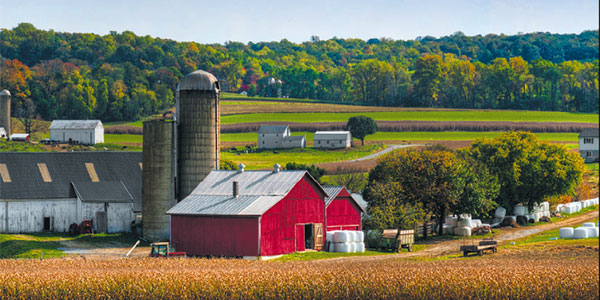

Welcome to Pennsylvania
There’s something for everyone in the Keystone State. City types can dive headlong into the theaters, museums, restaurants and shopping centers of Philadelphia and Pittsburgh—Pennsylvania’s two major cities. Outdoorsy types can trek into the “Pennsylvania Wilds” or explore the foothills, peaks and valleys of the rolling Appalachian Mountains.
If you’re a sports fan, you can whet your appetite for just about any type of matchup. With teams like the Eagles and Steelers (NFL), 76ers (NBA), Pirates and Phillies (MLB), Penguins and Flyers (NHL), and the Union (MLS) all calling the Keystone State home, you can catch a pro game just about any time of year.
Pennsylvania is also the land of amusement parks, so if you’re traveling with kids, be prepared to stop at more than a few. Of particular note is Knoebels Amusement Resort in eastern Pennsylvania. It’s the country’s largest free-admission amusement park, making it an ideal place to stop on your travels.
Other highlights around the state include the Gettysburg Museum, Independence Hall in Philadelphia, Phipps Conservatory and Botanical Gardens in Pittsburgh, the National Aviary in Pittsburgh and the American Music Theatre in Lancaster.

Adventure
Pennsylvania is almost entirely covered with mountains, resulting in a landscape full of scenic hills, valleys, plateaus and ridges. Toss in the fact that more than half the state is draped in thick forest, and you have yourself a nature enthusiast’s haven.
Ricketts Glen State Park in northeastern Pennsylvania is listed as a National Natural Landmark and is a must-visit spot for all. It features old-growth woodlands, a diverse array of wildlife and an abundance of waterfalls. It’s also home to the 7.2-mile Falls Trail hiking loop, a 600-foot beach and a 245-acre lake (in which fishing and boating are allowed).
Ohiopyle State Park in southwestern Pennsylvania is home to the gushing and rushing waters of the Youghiogheny River Gorge, making it a popular destination for whitewater rafters. But if braving the rapids isn’t quite your speed, the park also features hiking trails and the 27-mile Great Allegheny Passage bicycle route.
Of course, no trip to the Keystone State is complete without a stop at Pine Creek Gorge—the Grand Canyon of Pennsylvania. More than 1,000 feet deep and 50 miles long, the Gorge is a sight to behold.
Entertainment
If you’re visiting the Keystone State in early February, you’ll want to swing through the central Pennsylvania borough of Punxsutawney, where you can take in the state’s internationally renowned Groundhog Day event. Held on February 2nd every year since 1886, it involves a weather-predicting groundhog named Punxsutawney Phil. If he emerges from his burrow and sees his shadow, it means six more weeks of winter are in store. If he doesn’t see his shadow, Pennsylvanians can look forward to the arrival of an early spring.
In March, the largest indoor flower show in the world sets up shop in Philadelphia. First started in 1829, the Philadelphia Flower Show dazzles guests with displays and exhibits showcasing flowers and plants from all over the world.
During the summer months, visitors to the Keystone State will find an abundance of festivals and events to keep them entertained. The major highlights include the Odunde Festival in Philadelphia (a massive street market celebrating African and African-American culture) and the Three Rivers Arts Festival in Pittsburgh (a 10-day celebration of the arts that’s entirely free to the public).
Finally, if you’re in Philadelphia at the beginning of July, don’t miss the city’s renowned Fourth of July festivities. This is, after all, where the Declaration of Independence was drafted and signed.
Heritage
As one of the original 13 colonies, Pennsylvania has no shortage of history or historic sites.
It was here, in 1776, that the Declaration of Independence was penned, adding impetus to the American Revolution and serving as a cornerstone for the nation in centuries to follow. After the war, Pennsylvania became the second state to ratify the US Constitution. From 1790 to 1800, Philadelphia served as the nation’s capital. And at the climax of the Civil War, the state played host to the Battle of Gettysburg, which brought an end to the Confederacy’s northern advance and led to Lincoln’s famous Gettysburg Address.